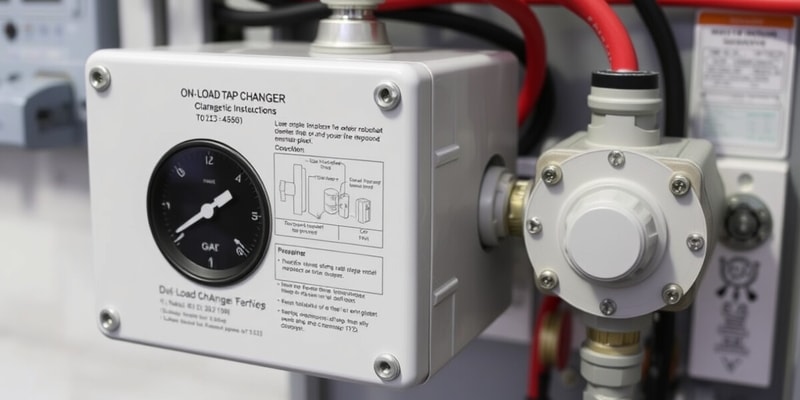Podcast
Questions and Answers
What is the diameter of the roller pin in the helical gear of on-load tap-changers type VACUTAP RMV-II?
What is the diameter of the roller pin in the helical gear of on-load tap-changers type VACUTAP RMV-II?
When should the front Geneva wheel be replaced in on-load tap-changers type VACUTAP RMV-II?
When should the front Geneva wheel be replaced in on-load tap-changers type VACUTAP RMV-II?
What is the recommended action if the helical gear was replaced during an Intermediate Maintenance?
What is the recommended action if the helical gear was replaced during an Intermediate Maintenance?
Which of the following on-load tap-changers type VACUTAP RMV-II requires the replacement of two bolts at the P connection?
Which of the following on-load tap-changers type VACUTAP RMV-II requires the replacement of two bolts at the P connection?
Signup and view all the answers
What is the first step in the procedure of inspection and replacement of the two bolts at the P connection?
What is the first step in the procedure of inspection and replacement of the two bolts at the P connection?
Signup and view all the answers
What is the production period for which the replacement of two bolts at the P connection is required?
What is the production period for which the replacement of two bolts at the P connection is required?
Signup and view all the answers
What type of maintenance is recommended for replacing the helical gear if it was replaced during an Intermediate Maintenance?
What type of maintenance is recommended for replacing the helical gear if it was replaced during an Intermediate Maintenance?
Signup and view all the answers
What is the reason for replacing the helical gear with 10 mm roller pin in on-load tap-changers type VACUTAP RMV-II?
What is the reason for replacing the helical gear with 10 mm roller pin in on-load tap-changers type VACUTAP RMV-II?
Signup and view all the answers
What is the approximated time required for switching from tap position n to n+1?
What is the approximated time required for switching from tap position n to n+1?
Signup and view all the answers
Which points are directly connected in the switching sequence?
Which points are directly connected in the switching sequence?
Signup and view all the answers
What is the purpose of CT in the switching sequence?
What is the purpose of CT in the switching sequence?
Signup and view all the answers
Which of the following is NOT a part of the switching sequence?
Which of the following is NOT a part of the switching sequence?
Signup and view all the answers
What is the relationship between tap n and tap n+1?
What is the relationship between tap n and tap n+1?
Signup and view all the answers
What is the function of P2 and P3 in the switching sequence?
What is the function of P2 and P3 in the switching sequence?
Signup and view all the answers
What is the purpose of VI in the switching sequence?
What is the purpose of VI in the switching sequence?
Signup and view all the answers
What is the type of reactor in the switching sequence?
What is the type of reactor in the switching sequence?
Signup and view all the answers
In the given switching sequence diagram, what is the primary function of the component labeled 'IL'?
In the given switching sequence diagram, what is the primary function of the component labeled 'IL'?
Signup and view all the answers
What does the abbreviation 'OLTC' stand for in the context of the given diagram?
What does the abbreviation 'OLTC' stand for in the context of the given diagram?
Signup and view all the answers
In the diagram, the component labeled 'VI' is most likely a:
In the diagram, the component labeled 'VI' is most likely a:
Signup and view all the answers
According to the diagram, what is the approximate duration of each phase in the switching sequence from tap position 'n' to 'n+1'?
According to the diagram, what is the approximate duration of each phase in the switching sequence from tap position 'n' to 'n+1'?
Signup and view all the answers
The component labeled 'CT' in the diagram is most likely a:
The component labeled 'CT' in the diagram is most likely a:
Signup and view all the answers
What is the primary function of the switching sequence described in the diagram?
What is the primary function of the switching sequence described in the diagram?
Signup and view all the answers
What is the name of the type of transformer used in the diagram?
What is the name of the type of transformer used in the diagram?
Signup and view all the answers
The switching sequence described in the diagram is for moving from tap position 'n' to 'n+1.' What does 'n+1' likely represent?
The switching sequence described in the diagram is for moving from tap position 'n' to 'n+1.' What does 'n+1' likely represent?
Signup and view all the answers
What does the cam position indicate when the UVT-LTX is in Neutral?
What does the cam position indicate when the UVT-LTX is in Neutral?
Signup and view all the answers
In the switching sequence of the Reactor Type OLTC VACUTAP® RMV, which is the initial tap position when moving from tap position n to n+1?
In the switching sequence of the Reactor Type OLTC VACUTAP® RMV, which is the initial tap position when moving from tap position n to n+1?
Signup and view all the answers
What time duration is approximately indicated for each step in the switching sequence?
What time duration is approximately indicated for each step in the switching sequence?
Signup and view all the answers
In the context of the switching sequence, what does 'Non-Bridging Position' refer to?
In the context of the switching sequence, what does 'Non-Bridging Position' refer to?
Signup and view all the answers
What is the sequence identifier for the RMV Switching Sequence mentioned in the content?
What is the sequence identifier for the RMV Switching Sequence mentioned in the content?
Signup and view all the answers
Which term is used to describe the time elapsed during the transition between tap positions in the sequence?
Which term is used to describe the time elapsed during the transition between tap positions in the sequence?
Signup and view all the answers
What component is specifically excluded from the switching sequence diagram provided?
What component is specifically excluded from the switching sequence diagram provided?
Signup and view all the answers
What is the key function of the Reactor Type OLTC VACUTAP® RMV in this context?
What is the key function of the Reactor Type OLTC VACUTAP® RMV in this context?
Signup and view all the answers
What is the approximate time duration for the switching sequence from tap position n+1 to n in the reactor type OLTC VACUTAP® RMV?
What is the approximate time duration for the switching sequence from tap position n+1 to n in the reactor type OLTC VACUTAP® RMV?
Signup and view all the answers
What does the "AIW" label represent in the diagram illustrating the switching sequence?
What does the "AIW" label represent in the diagram illustrating the switching sequence?
Signup and view all the answers
Which of the following components is NOT directly involved in the switching sequence from tap position n+1 to n?
Which of the following components is NOT directly involved in the switching sequence from tap position n+1 to n?
Signup and view all the answers
What is the likely function of the "P" components labelled in the diagram?
What is the likely function of the "P" components labelled in the diagram?
Signup and view all the answers
Based on the diagram, what is the likely function of the "Ic" component?
Based on the diagram, what is the likely function of the "Ic" component?
Signup and view all the answers
During the switching sequence, what is the most likely reason for the involvement of "IL" (Inductive Load)?
During the switching sequence, what is the most likely reason for the involvement of "IL" (Inductive Load)?
Signup and view all the answers
What is the likely purpose of the "Bridging Position" in the switching sequence?
What is the likely purpose of the "Bridging Position" in the switching sequence?
Signup and view all the answers
What is the key difference between the two diagrams provided, representing the switching sequence?
What is the key difference between the two diagrams provided, representing the switching sequence?
Signup and view all the answers
Study Notes
Replacement Procedures for VACUTAP® RMV-II On-load Tap-changers
- All VACUTAP® RMV-II on-load tap-changers produced from January 26, 2017, feature a helical gear equipped with a 10 mm roller pin.
- The helical gear and the front Geneva wheel must be replaced after 1,000,000 tap-change operations.
- If the helical gear is replaced during Intermediate Maintenance, it is advisable to replace it again during the next General Standard Maintenance to maintain consistent maintenance timelines.
Inspection and Replacement of Bolts
- Inspection and replacement of two bolts at the P connection is required for VACUTAP® RMV-II tap-changers delivered between September 2019 and February 2020.
- Applicable models for bolt replacement include VACUTAP RMV-II 600A and 1,000A at voltages of 15 and 26.4kV.
- Ensure high and low side breakers are open and that the transformer is grounded before beginning servicing.
Switching Sequence for VACUTAP® RMV
- The switching sequence for reactor type OLTC VACUTAP® RMV operates from tap position n to n+1 within approximately 2000 ms.
- Key components involved in the switching include P1, P2, P3, P4, and their respective current and voltage indicators.
- The system can transition from a non-bridging to a bridging position, highlighting the intricate functioning of the VACUTAP® RMV switching mechanism.
Maintenance Recommendations
- Consistent documentation of replacements in the service report is essential for tracking the maintenance schedule of tap-changers and adhering to operational standards.
- The maintenance of on-load tap-changers is crucial to ensure optimal performance and longevity, following precise operational guidelines.
Studying That Suits You
Use AI to generate personalized quizzes and flashcards to suit your learning preferences.
Related Documents
Description
Learn about the replacement procedures for VACUTAP RMV-II on-load tap-changers, including when to replace the helical gear and front Geneva wheel. Understand the maintenance timelines and guidelines for optimal performance.




